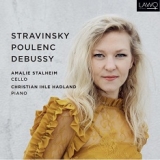Dass Epochen-Einordnungen in der Musik nicht mehr als eine Krücke sind, zeigt diese Einspielung mit Werken von drei Komponisten, die man grundsätzlich als Zeitgenossen bezeichnen kann, deren musikalische Sprache sich aber grundlegend unterscheidet. Allein daraus erwächst schon die Attraktivität dieser Produktion, die dank der Interpretationen allerdings noch gesteigert wird.
Stravinskys Suite italienne entführt uns in die neo-barocke Phase des Komponisten, deren Grundgedanken (Altes in Neues kleiden) Amalie Stalheim und Christian Ihle Hadland von Beginn erfassen. Die Musik atmet mediterrane Leichtigkeit, barocken Schwung, atemberaubende Filigranität (Tarantella) – alles, was diese köstliche Musik von Stravinsky ausmacht.
In der Poulenc-Sonate sticht dann die Expressivität, die innere Kraft, die der Musik entlockt wird, hervor. Amalie Stalheim treibt die Intensität ihres Spiels jedoch nie zu weit, lässt der Musik ihren eigenen Raum und lässt ihr Instrument immer wieder wunderbar singen. Beides verleiht dieser Sonate wunderbare Kontraste und starkes Relief, wobei die nahezu mystische Stimmung der Cavatine – die spirituelle Seite Poulencs – besonders hervorzuheben ist.
Zum Abschluss hören wir dann noch Debussy einzige Cellosonate – wieder ein ganz anderes Klangbild, eine andere Stimmung. Amalie Stalheim und Christian Ihle Hadland erschaffen durch unterschiedlichste Stilmittel eine Atmosphäre von Brüchen, von Melancholie und Leidenschaft, von Trauer und Aufbegehren, Spiegel einer Zeit, in der die Welt am Abgrund stand.
Mit 49 Minuten ist die Spielzeit vergleichsweise kurz geraten, aber hier ist weniger definitiv mehr: ein kurzes aber packendes Programm.
That epoch classifications in music are no more than a crutch is shown by this recording with works by three composers who can basically be called contemporaries, but whose musical language differs fundamentally. That alone gives rise to the appeal of this production, though it is heightened thanks to the interpretations.
Stravinsky’s Suite italienne takes us into the composer’s neo-baroque phase, whose basic ideas (dressing the old in the new) Amalie Stalheim and Christian Ihle Hadland grasp from the start. The music breathes Mediterranean lightness, Baroque verve, breathtaking filigree (Tarantella) – everything that makes up this delicious music by Stravinsky.
Then in the Poulenc Sonata, the expressiveness, the inner power elicited from the music stands out. Amalie Stalheim never pushes the intensity of her playing too far, however, allowing the music its own space and letting her instrument sing wonderfully again and again. Both lend wonderful contrasts and strong relief to this sonata, with the almost mystical mood of the Cavatine – Poulenc’s spiritual side – particularly noteworthy.
Finally, we hear Debussy’s only cello sonata with a completely different sound, a different mood. Amalie Stalheim and Christian Ihle Hadland create an atmosphere of ruptures, of melancholy and passion, of mourning and rebellion, mirrors of a time when the world was on the brink.
With 49 minutes the playing time is comparatively short, but here less is definitely more: a short but gripping program.
























